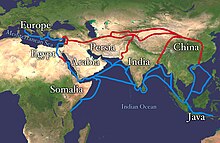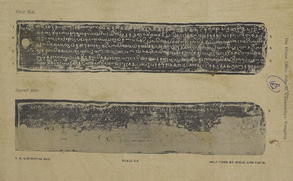Ay dynasty
Ay | |||||||
|---|---|---|---|---|---|---|---|
 Ay Kingdom in 1st Century CE | |||||||
| Capital |
| ||||||
| Common languages | Old Tamil | ||||||
| Religion | Hinduism | ||||||
| |||||||
Ay was an ancient
The Ay formed one of the major chieftains of early historic (pre-
The medieval Ay lineage has its origins in the hill-chiefs of early historic (pre-
Origin
In his introduction to Lilathilakam, Attur Krishna Pisharodi is giving an account of Chiravayi says that the Ayar family who were ruling the regions near Ayakkudi (in Shencotta) and other places, were defeated by the Pandyas in the 8th century CE and they migrated to Vizhinjam, a sea port eight miles south-east of Trivandrum.[9][10][11]
The name Ay is derived from the early
The Ay kings continued to cherish their association with the
The medieval Ay(ahirs) claimed that they belonged to the Yadava or
The Huzur copper plates mention that Ay king Karunandadakkan mentions himself as Srivallabha born to Nanda of yadava race. [17]
History


The Ay clan was one of the major hill-chiefs of early historic south India.
Ay chieftains of early historic south India
A number of Ay chiefs such as Andiran, Titiyan and Atiyan are mentioned in the early Tamil poems.[3]
- Ay Andiran is praised by early Tamil poets such as Mudamochiyar, Odakizhar, and Kiranar in Purananuru.[3] He is mentioned in the Purananuru as the "Lord of Podiyil Mala" in southern Western Ghats. He is said to have defeated the Kongu chiefs and pursued them to the Arabian Sea. He was an elder contemporary of the Chera chief Antuvan Cheral.[4]
- Ay Titiyan (the Podiyil Chelvan) is praised by authors Paranar and Bhuta Pandya (the
- Ay Atiyan, successor to Ay Titiyan, is mentioned by authors Paranar and Madurai Kanakkayanar in Akananuru. Paranar and Kanakkayanar also mention Podiyil Mala, the Ay base, as the property of Pachupun Pandya (Azhakiya Pandya), the successor to Bhuta Pandya.[3]
- An Ay ruler took part in the famous battle of Talai-yalankanam, in which the Pandya chief Nedum Chezhiyan defeated several of his enemies.[4]
Originally the whole region of Venad (Vel+natu = the country of the Vel people, related to the Ay family) was part of the larger Ay-Vel territory.[18] Persons (the Vels) belonging to the Ay family were the chieftains of the Vel country.[19]
- Veliyan Venmal Nallini was the wife of the Chera chieftain Utiyan.[19]
- Veliyan Venman Ay Eyinan was the leader of the Chera warriors against Nannan of Ezhimalai.[19]
Pandya foray into the Ay country

In c. 765 CE,
The Pandya foray into south Kerala brought the
- The Pandya king "Maran Chadayan" Jatila Paranthaka destroyed a fort at Aruviyoor (Aruvikkarai near Thalakulam) by defeating Chadayan Karunanthan of "Malai Nadu" in 788 CE (23rd year, Kalukumalai inscription).[19]
- In 792 CE (27th year, Jatila Paranthaka) the Chera warriors (the Cheramanar Padai) are seen fighting for a fort at Vizhinjam and at Karaikkotta (Karaikkodu near Thalakulam) against a commander of Maran Chadayan (Trivandrum Museum Inscription of Maran Chadayan).[18]
Detachment of Venad
In the 9th century, as a result of the encroachment of the Pandyas and Chera-Perumals, the ancient Ay territory was partitioned into two portions.
Srimara Srivallabha was succeeded on the Pandya throne by Varaguna II (r. 862–885 CE).[3] The Ay kings of Vizhinjam remained vassals of the Pandyas, as indicated by the surname of the then king Vikramaditya (r. c. 884–911/920 CE[6]).[3]
The Pandyas were defeated in the "great battle of Sripurambiyam" in c. 885 CE.
The chieftains of Venad, owing allegiance to the Chera-Perumals, were determined on extending their sway into the Ay kingdom.[3] Their opportunity might have came in the disorder following the Chola defeat at Takkolam (mid-10 century CE).[3] The Venad chieftains were eventually successful in capturing the whole Ay country down to Kottaru.[3] In general, the influence of the Kerala rulers spread into the southern Ay territory in the 10th century CE.[8]
Chola influence in Ay country
The famous salai at Kantalur, somewhere near present-day
The entire region to the south of
Major medieval Ay grants
| Grant name | Date | Notes | |
|---|---|---|---|
| Karunanthadakkkan Srivallabha (r. c. 856/57–884 CE) | |||
| Parthivapuram Grant
(Trivandrum Huzur Office Plates) |
Regnal year 9 = 865 CE |  | |
| Tiruvidaikkodu inscription I | Regnal year 14 = 870 CE |  | |
| Tiruvidaikkodu inscription II | Regnal year 22 = 878 CE | ||
| Vikramaditya Varaguna (r. c. 884–911/920 CE) | |||
| Thirupparappu Plates[30][6] | 9th century CE[30] |
|
 |
| Thirunandikkarai (Trivandrum Huzur Office Plates) | Regnal year 8 = 892 CE |  | |
Paliyam Copper Plates
|
898 CE[25] |  | |
See also
- Velir
- Vizhinjam
- Pandya dynasty
- Chera dynasty
- Cheras of Makotai
References
- ^ Narayanan, M. G. S. Perumāḷs of Kerala. Thrissur (Kerala): CosmoBooks, 2013. 179.
- ^ a b Gurukkal, Rajan. “DID STATE EXIST IN THE PRE-PALLAVAN TAMIL REGION.” Proceedings of the Indian History Congress, vol. 63, 2002, pp. 138–150.
- ^ a b c d e f g h i j k l m n o p q r Narayanan, M. G. S. Perumāḷs of Kerala. Thrissur (Kerala): CosmoBooks, 2013. 191 - 193, 435 - 437. [1]
- ^ ISBN 978-81-264-1578-6 [2]
- ^ S2CID 145359607.
- ^ a b c d e Gurukkal, Rajan. The Agrarian System and Socio-Political Organisation Under the Early Pandyas c. CE 600-1000. Doctoral Thesis. Jawaharlal Nehru University, 1984. 29-30.
- ^ a b Noburu Karashmia (ed.), A Concise History of South India: Issues and Interpretations. New Delhi: Oxford University Press, 2014. 122-24.
- ^ a b c d e Ganesh, K. N. Agrarian Relations and Political Authority in Medieval Travancore (A. D. 1300-1750). Doctoral Thesis. Jawaharlal Nehru University, 1987. 22-25.
- ISBN 9788185692272.
- ^ Nair, Adoor K. K. Ramachandran (1986). Kerala State Gazetteer, Volume 2. State Editor, Kerala Gazetteers, 1986. p. 47.
- ^ Journal of Kerala Studies, Volume 14. University of Kerala., 1987. 1987. p. 14.
- ^ A Dictionary Of The Tamil And English Languages, Volume 1, Page 131
- ISBN 9788170173984.
- ISBN 9788170173984.
- ^ Aiya, V. Nagam. The Travancore State Manual. Vol 1. Part 2. Trivandrum: The Travancore Government Press, 1906 [3]
- S2CID 162972188.
- ^ T, Rao (1910). Travancore archaeological series. Trivandrum. p. 4.
- ^ a b Narayanan, M. G. S. Perumāḷs of Kerala. Thrissur (Kerala): CosmoBooks, 2013. 75.
- ^ a b c d Narayanan, M. G. S. Perumāḷs of Kerala. Thrissur (Kerala): CosmoBooks, 2013. 106.
- ^ a b c Narayanan, M. G. S. Perumāḷs of Kerala. Thrissur (Kerala): CosmoBooks, 2013. 93-94.
- ^ a b Narayanan, M. G. S. Perumāḷs of Kerala. Thrissur (Kerala): CosmoBooks, 2013. 94-95.
- ^ Narayanan, M. G. S. Perumāḷs of Kerala. Thrissur (Kerala): CosmoBooks, 2013. 107.
- ^ a b c Narayanan, M. G. S. Perumāḷs of Kerala. Thrissur (Kerala): CosmoBooks, 2013. 97.
- ^ Narayanan, M. G. S. Perumāḷs of Kerala. Thrissur (Kerala): CosmoBooks, 2013. 96-98.
- ^ a b Narayanan, M. G. S. Perumāḷs of Kerala. Thrissur (Kerala): CosmoBooks, 2013. 109-110.
- ^ Narayanan, M. G. S. Perumāḷs of Kerala. Thrissur (Kerala): CosmoBooks, 2013. 118-119 and 137-138.
- ^ a b c d e Rao, T. A. Gopinatha. Three Inscriptions of Kokkarunandadakkar. Travancore Archaeological Series. Vol. I (1910 ed.). Madras: Government of Travancore. pp. 10–14.
- ^ ISBN 978-90-474-0147-6.
- ^ a b c d Rao, T. A. Gopinatha. Three Inscriptions of Kokkarunandadakkar. Travancore Archaeological Series. Vol. I (1910 ed.). Madras: Government of Travancore. pp. 14–15.
- ^ a b c Rao, T. A. Gopinatha. Tirupparappu Fragmentary Set of Copper-Plates. Travancore Archaeological Series. Vol. XIII (1912 ed.). Madras: Government of Travancore. pp. 197–99.
- ^ a b c Rao, T. A. Gopinatha. The Huzur Office Plate of Vikramaditya Varaguna. Travancore Archaeological Series. Vol. I (1910 ed.). Madras: Government of Travancore. pp. 02–03.
- ^ Rao, T. A. Gopinatha. Two Inscriptions of Vikramaditya Varaguna. Travancore Archaeological Series. Vol. XII (1912 ed.). Madras: Government of Travancore. pp. 192–93.
